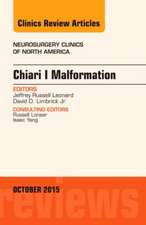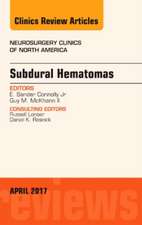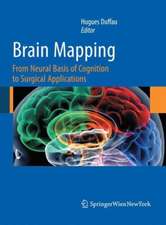Acute Care Neurosurgery by Case Management: Pearls and Pitfalls
Editat de P. B. Raksinen Limba Engleză Hardback – 2 sep 2022
This book reviews the common clinical scenarios that might trigger emergent consultation for neurosurgical intervention, with attention to key components of the clinical interview and exam, optimal diagnostic evaluation, indications for and the goals of operative intervention, perioperative considerations, and strategies for complication mitigation. This is not a surgical atlas, but rather, a road map for the journey to the operating room door. The intent is to establish a systematic, evidence-based action plan for the patient presenting in neurologic crisis.
Each chapter opens with a relevant case vignette and then unfolds through uniform sections to tell the story of how one might approach the disease entity in question, from initial request for consultation to definitive management, highlighting steps of the decision-making process:
• What are the highest yield questions to ask during a focused interview?
• What are the most pertinent objective exam findings?
• What is the proper differential diagnosis?
• What is the most appropriate and efficient plan for diagnostic evaluation – with respect to laboratories and imaging? • Does this patient have an indication for emergent or urgent neurosurgical intervention?
• If so, what is the goal of that intervention?
• What are the most common potential complications of the proposed procedure, and what steps might be taken to mitigate those risks?
Each chapter is punctuated by 3-5 teaching pearls, summarizing these key elements. The overall goal is to create a framework for assessment that might be applied in the emergency department, the trauma bay, or the ICU when a neurologic emergency arises.
The scope of the text encompasses not only cranial and spinal trauma, but also entities such as shunt failure, stroke, aneurysmal subarachnoid hemorrhage, pituitary apoplexy, cauda equina syndrome, and central nervous system infection that might require time-sensitive intervention. An additional section addresses issues requiring emergent neurosurgical response in the ICU setting, including sudden neurologic worsening, status epilepticus, and abnormal clotting/ coagulopathy.
The text will not only serve as a valuable resource for those preparing to take the oral board exam, but will also provide a targeted refresher for clinicians taking general neurosurgical call in the community as well as an educational reference for mid-level practitioners and those in training who are serving as first responders on behalf of a neurosurgical service.
Each chapter opens with a relevant case vignette and then unfolds through uniform sections to tell the story of how one might approach the disease entity in question, from initial request for consultation to definitive management, highlighting steps of the decision-making process:
• What are the highest yield questions to ask during a focused interview?
• What are the most pertinent objective exam findings?
• What is the proper differential diagnosis?
• What is the most appropriate and efficient plan for diagnostic evaluation – with respect to laboratories and imaging? • Does this patient have an indication for emergent or urgent neurosurgical intervention?
• If so, what is the goal of that intervention?
• What are the most common potential complications of the proposed procedure, and what steps might be taken to mitigate those risks?
Each chapter is punctuated by 3-5 teaching pearls, summarizing these key elements. The overall goal is to create a framework for assessment that might be applied in the emergency department, the trauma bay, or the ICU when a neurologic emergency arises.
The scope of the text encompasses not only cranial and spinal trauma, but also entities such as shunt failure, stroke, aneurysmal subarachnoid hemorrhage, pituitary apoplexy, cauda equina syndrome, and central nervous system infection that might require time-sensitive intervention. An additional section addresses issues requiring emergent neurosurgical response in the ICU setting, including sudden neurologic worsening, status epilepticus, and abnormal clotting/ coagulopathy.
The text will not only serve as a valuable resource for those preparing to take the oral board exam, but will also provide a targeted refresher for clinicians taking general neurosurgical call in the community as well as an educational reference for mid-level practitioners and those in training who are serving as first responders on behalf of a neurosurgical service.
| Toate formatele și edițiile | Preț | Express |
|---|---|---|
| Paperback (1) | 720.31 lei 6-8 săpt. | |
| Springer International Publishing – 3 sep 2023 | 720.31 lei 6-8 săpt. | |
| Hardback (1) | 673.67 lei 38-44 zile | |
| Springer International Publishing – 2 sep 2022 | 673.67 lei 38-44 zile |
Preț: 673.67 lei
Preț vechi: 709.13 lei
-5% Nou
Puncte Express: 1011
Preț estimativ în valută:
128.92€ • 139.99$ • 108.29£
128.92€ • 139.99$ • 108.29£
Carte tipărită la comandă
Livrare economică 18-24 aprilie
Preluare comenzi: 021 569.72.76
Specificații
ISBN-13: 9783030995119
ISBN-10: 3030995119
Pagini: 361
Ilustrații: XVIII, 361 p. 71 illus., 26 illus. in color.
Dimensiuni: 155 x 235 mm
Greutate: 0.75 kg
Ediția:1st ed. 2022
Editura: Springer International Publishing
Colecția Springer
Locul publicării:Cham, Switzerland
ISBN-10: 3030995119
Pagini: 361
Ilustrații: XVIII, 361 p. 71 illus., 26 illus. in color.
Dimensiuni: 155 x 235 mm
Greutate: 0.75 kg
Ediția:1st ed. 2022
Editura: Springer International Publishing
Colecția Springer
Locul publicării:Cham, Switzerland
Cuprins
Hemorrhagic stroke – spontaneous intracerebral hemorrhage.- Cerebellar stroke and suboccipital trauma.- Venous sinus thrombosis.- Aneurysmal subarachnoid hemorrhage.- Pituitary apoplexy.- Hydrocephalus and shunt failure.- Cerebrospinal fluid fistulae.- Acute epidural compression syndromes of the spinal canal – epidural hematoma, metastatic disease, abscess.- Cauda equina syndrome.- Initial evaluation of concussion.- Epidural and subdural hematoma.- Cerebral contusion.- Penetrating brain injury.- Traumatic arterial vascular and venous injuries.- Decompressive craniectomy – for stroke, trauma.- Cervical spine fractures.- Thoracolumbar fractures.- Central cord syndrome.- Approach to the patient with acute neurologic worsening.- Status epilepticus.- Central nervous system infection.- Abnormal clotting and coagulopathy.- Fever.
Notă biografică
P.B. Raksin, MD
Associate Professor of Neurological Surgery
Rush University Medical Center
Director, Neurosurgery ICU
John H. Stroger Jr Hospital of Cook County (formerly Cook County Hospital)
patricia_b_raksin@rush.edu
Associate Professor of Neurological Surgery
Rush University Medical Center
Director, Neurosurgery ICU
John H. Stroger Jr Hospital of Cook County (formerly Cook County Hospital)
patricia_b_raksin@rush.edu
Textul de pe ultima copertă
This book reviews the common clinical scenarios that might trigger emergent consultation for neurosurgical intervention, with attention to key components of the clinical interview and exam, optimal diagnostic evaluation, indications for and the goals of operative intervention, perioperative considerations, and strategies for complication mitigation. This is not a surgical atlas, but rather, a road map for the journey to the operating room door. The intent is to establish a systematic, evidence-based action plan for the patient presenting in neurologic crisis.
Each chapter opens with a relevant case vignette and then unfolds through uniform sections to tell the story of how one might approach the disease entity in question, from initial request for consultation to definitive management, highlighting steps of the decision-making process. Each chapter is punctuated by 3-5 teaching pearls, summarizing these key elements. The overall goal is to create a framework for assessment that might be applied in the emergency department, the trauma bay, or the ICU when a neurologic emergency arises. The scope encompasses not only cranial and spinal trauma, but also entities such as shunt failure, stroke, aneurysmal subarachnoid hemorrhage, pituitary apoplexy, cauda equina syndrome, and central nervous system infection that might require time-sensitive intervention. An additional section addresses issues requiring emergent neurosurgical response in the ICU setting, including sudden neurologic worsening, status epilepticus, and abnormal clotting/ coagulopathy.
Each chapter opens with a relevant case vignette and then unfolds through uniform sections to tell the story of how one might approach the disease entity in question, from initial request for consultation to definitive management, highlighting steps of the decision-making process. Each chapter is punctuated by 3-5 teaching pearls, summarizing these key elements. The overall goal is to create a framework for assessment that might be applied in the emergency department, the trauma bay, or the ICU when a neurologic emergency arises. The scope encompasses not only cranial and spinal trauma, but also entities such as shunt failure, stroke, aneurysmal subarachnoid hemorrhage, pituitary apoplexy, cauda equina syndrome, and central nervous system infection that might require time-sensitive intervention. An additional section addresses issues requiring emergent neurosurgical response in the ICU setting, including sudden neurologic worsening, status epilepticus, and abnormal clotting/ coagulopathy.
Caracteristici
Chapters open with a relevant case vignette and includes 3-5 teaching pearls Reviews common clinical scenarios that might trigger emergent consultation for neurosurgical intervention Establishes a systematic, evidence-based action plan for the patient presenting in neurologic crisis





















